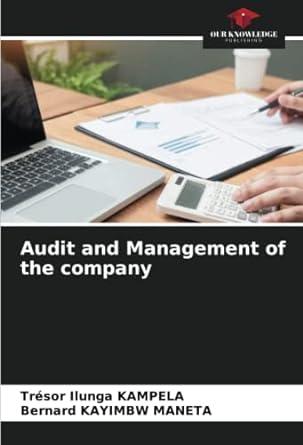Question
11. Conversion costs are A. often assumed to be added at the beginning of the production process in each department. B. the sum of the
11. Conversion costs are
A. often assumed to be added at the beginning of the production process in each department. B. the sum of the direct materials and direct labor costs. C. impossible to measure for any particular department. D. often assumed to be added evenly throughout the process within the department.
12. The equivalent units are calculated by:
A. taking the units needed to complete the beginning inventory, adding the units started and taking the equivalent units in ending inventory. B. taking the units completed plus the equivalent units in ending inventory. C. taking the total units to account for and subtracting the equivalent units in beginning inventory. D. taking the units started plus the equivalent units in ending inventory.
13. Department A began the period with 45,000 units. During the period the department received another 30,000 units from the prior department and completed 60,000 units during the period. The remaining units were 75% complete. The amount of equivalent units in Department As work-in-process inventory at the end of the period is: A. 30,000. B. 22,500. C. 15,000. D. 11,250. 14. Which of the following costs is least likely to be a variable cost?
A. sales commissions B. direct labor C. indirect materials D. supervisory salaries
15. Which of the following components are included in a mixed cost?
A. a sunk cost and an opportunity cost B. a fixed cost and a variable cost C. a manufacturing cost and a selling cost D. a product cost and a period cost
16. Which of the following is not a method that is used to estimate variable and fixed costs?
A. account analysis B. high low method C. east-west method D. regression analysis
17. Karis Kookies has total costs of $5,000 when 2,000 units are produced and $11,000 when 5,000 units are produced. What is the variable cost per unit?
A. $2.50 B. $2.20 C. $2.00 D. $0.50
18. Which of the following items appears on a contribution margin income statement but not on a GAAP income statement?
A. Sales B. Gross margin C. Net income D. Contribution margin
19.. Which of the following is not a reason that companies allocate costs?
A. to calculate the full cost of products for financial reporting purposes B. to discourage managers from using external suppliers C. to reduce the frivolous use of company resources D. to provide information needed by managers to make appropriate decisions
20. The cost objective is the
A. reason for allocating the cost. B. calculation based on budgeted amounts. C. product, service, or department that is to receive the allocation. D. maximum amount to be allocated to any single department.
21. An allocation base
A. is the minimum amount to be allocated to a cost object. B. coordinates the manufacturing overhead costs as they are incurred. C. will always be less than the variable costs for a product. D. relates the cost pool to the cost objectives.
Step by Step Solution
There are 3 Steps involved in it
Step: 1

Get Instant Access to Expert-Tailored Solutions
See step-by-step solutions with expert insights and AI powered tools for academic success
Step: 2

Step: 3

Ace Your Homework with AI
Get the answers you need in no time with our AI-driven, step-by-step assistance
Get Started


